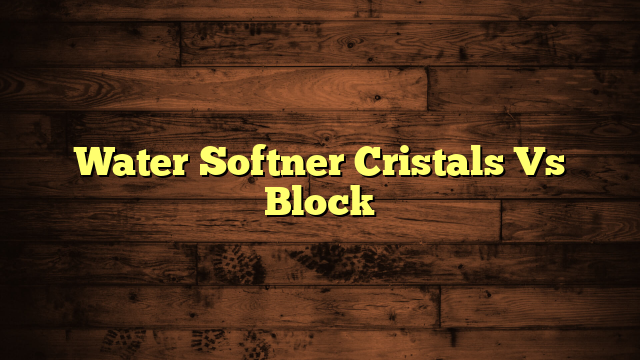Transform Your Mobile Home: The Best Water Softener Placement
When it comes to improving the quality of water in your mobile home, installing a water softener is one of the best decisions you can make. Not only will it eliminate the negative effects of hard water, but it will also protect your appliances, pipes, and improve your overall quality of life.
But where should you install the water softener to ensure it works efficiently? In this comprehensive guide, we’ll cover the best water softener placement options in your mobile home, along with expert tips and considerations to help you make the right choice.
Key Considerations Before Installing a Water Softener in Your Mobile Home
Selecting the right location for a water softener in a mobile home involves several considerations to guarantee peak performance and easy maintenance:
Proximity to the Main Water Line
Installing your water softener near the main water line is crucial for ensuring all the water entering your home is treated. This placement prevents hard water from reaching faucets, showers, appliances, and plumbing, which extends their lifespan and reduces maintenance needs.
Access to Drainage
Water softeners require proper drainage to handle the brine discharge during the regeneration cycle. Choosing a location with easy access to a drainage system is important for efficient operation.
Space Availability
Consider the space needed for both the water softener and any additional equipment (such as a brine tank). While a mobile home often has limited space, there are still options for creative placement.
Maintenance Accessibility
You’ll need to access the water softener regularly for salt refills, maintenance checks, and repairs. Choose a location that allows you to easily reach the system without too much hassle.
Ideal Locations for Water Softener Installation in Your Mobile Home
1. Near the Main Water Line
Installing the water softener as close to the main water line as possible is the best option for your mobile home. This setup ensures that all incoming water is softened, providing consistent water quality throughout your home. You won’t have to worry about hard water in your pipes, faucets, or appliances.
Key Advantages:
- Comprehensive Water Treatment: Treats all water entering the home, not just the water used for cooking or bathing.
- Simplified Installation: Reduces the complexity of installation as you won’t need to reroute pipes.
- Improved Water Quality: Prevents limescale buildup in plumbing and appliances.
💡Installation Tip: Find where the main water line enters your home, typically near the water meter or water supply point. This is the perfect place to install the softener for seamless integration into your plumbing system. Ensure you turn off the main water supply before beginning any installation work to avoid leaks.
2. In the Utility Room
A utility room is often the most convenient space for a water softener. These rooms are typically located close to the main water supply, providing easy access to plumbing and drainage systems. Utility rooms are also spacious enough to accommodate a water softener, making them an ideal choice for those with enough room.
Key Advantages:
- Proximity to Main Water Line: Since utility rooms are often close to the main water supply, installation is quick and efficient.
- Maintenance Accessibility: With easy access, you can easily check salt levels and perform routine maintenance.
- Brine Discharge: Utility rooms often have drains nearby, making it easy to set up the brine discharge system.
💡Installation Tip: Ensure that the utility room has enough space for the softener, as well as proper ventilation to allow the unit to function without excess moisture buildup. Having enough room for the brine tank and salt refills is also important for smooth operations.
3. In the Basement or Crawl Space
If you’re limited on space in your living area, a basement or crawl space might be the perfect solution. These areas typically offer ample room for a water softener, and installing it here keeps it out of sight. Basements also provide protection from extreme weather, such as freezing temperatures, which can damage the softener.
Key Advantages:
- Space Efficiency: Saves valuable living space in your mobile home.
- Easier Plumbing Access: Basements often offer easier access to plumbing, which simplifies installation.
- Reduced Noise: Water softeners can be noisy, and installing them in a basement or crawl space minimizes disturbances.
💡Installation Tip: Check the humidity levels in your basement or crawl space, as excess moisture could affect the softener’s performance. If humidity is a concern, consider installing a dehumidifier to maintain optimal conditions. Also, ensure the area has easy access for maintenance.
4. Under the Kitchen Sink
If you’re looking for immediate access to softened water for drinking, cooking, or washing dishes, placing the water softener under the kitchen sink may be the way to go. This setup provides softened water directly at the point of use, allowing you to enjoy the benefits of soft water every time you turn on the tap.
Key Advantages:
- Direct Access to Softened Water: Ensures water used for cooking, drinking, and washing dishes is always soft.
- Space Saving: Maximizes the use of available space without taking up additional room in your mobile home.
💡Installation Tip: Under-sink installations require careful planning. The space is typically smaller, so ensure the softener will fit and that plumbing adjustments are feasible. Consider hiring a professional plumber if you’re not experienced with plumbing work.
5. Above the Water Heater or Near Plumbing Fixtures
In some cases, placing the water softener above the water heater or near key plumbing fixtures may be the most practical solution. This location allows for easy connections to your home’s water supply while also saving space in your main living areas.
Key Advantages:
- Compact: Works well for smaller spaces and homes with limited room.
- Convenience: Reduces the need to run long pipes or make complex adjustments to the plumbing system.
💡Installation Tip: Ensure you have enough space to access the softener for maintenance tasks, including salt refills and filter changes.
Final Considerations for Water Softener Mobile Home Installation
- Pipe Compatibility: Ensure the water softener’s inlet and outlet connections match the size and type of pipes in your mobile home. If unsure, consult a plumber to avoid any leaks or pressure issues.
- Professional Installation: If you’re unsure about the installation process, consider hiring a professional to ensure everything is set up correctly and safely. A professional installation can also help prevent potential problems down the road.
- Regular Maintenance: Water softeners require regular maintenance, such as salt refills and system checks. Always monitor the performance of the system to keep it running efficiently.
Conclusion: Enjoy the Benefits of Soft Water in Your Mobile Home
Incorporating a water softener into your mobile home is a smart investment that pays off in the long run. Whether you choose to install it near the main water line, in the utility room, under the kitchen sink, or in a basement, make sure to consider the space, accessibility, and overall impact on your daily life.
(FAQs) Installing a Water Softener in Your Mobile Home
Installing a water softener in your mobile home can significantly enhance water quality and protect your plumbing and appliances. Below are some common questions and their answers to guide you through the process.
1. What is a water softener, and how does it work?
A water softener is a device that removes minerals like calcium and magnesium from hard water through a process called ion exchange. This process replaces these minerals with sodium or potassium ions, resulting in softened water that is gentler on your skin, hair, and household appliances.
2. How do I determine if my water is hard and needs softening?
You can test your water hardness using a home test kit or by contacting your local water utility for a water quality report. Water hardness is typically measured in grains per gallon (gpg); levels above 7 gpg are considered hard and may benefit from softening.
3. Where is the best location to install a water softener in a mobile home?
The ideal location is near the main water line, typically in the utility room, basement, or crawl space. This placement ensures that all water entering your home is treated. Ensure the area has adequate space, ventilation, and access for maintenance.
4. Can I install a water softener myself, or should I hire a professional?
While DIY installation is possible for those with basic plumbing skills, it’s essential to follow the manufacturer’s instructions carefully. If you’re uncertain or lack experience, hiring a professional plumber is recommended to ensure proper installation and avoid potential issues.
5. What maintenance does a water softener require?
Regular maintenance includes refilling the brine tank with salt, typically every 4-6 weeks, depending on water usage. Periodic cleaning and checking for leaks are also important. Refer to your softener’s manual for specific maintenance guidelines.
6. Will installing a water softener affect my water pressure?
Properly installed water softeners should not significantly affect water pressure. However, if the system is not sized correctly or installed improperly, it could lead to reduced pressure.







